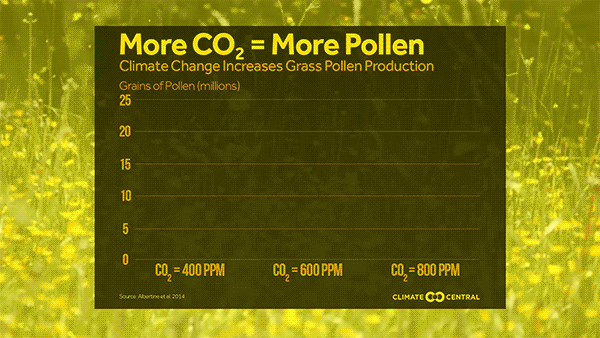Spring is in full swing, but for those suffering from pollen allergies, blossoming plants only worsen their sneezing and congestion. And it is not just inconvenient — reports of asthma are on the rise.
In a previous Climate Matters, we illustrated how ragweed pollen production increases with CO2 levels. New research continues to shed light on the relationship between pollen and climate change.
While ragweed studies give one example of how pollen is impacted by higher levels of CO2, other plants have also been subsequently examined. In this Climate Matters, we highlight a new study that looks at Timothy Grass pollen, a major cause of allergies during the early summer. Researchers investigated the amount of pollen produced at CO2 concentrations of 400 ppm, which is near current levels, and 800 ppm, which we would pass before the end of the century if current emissions trends continue. Not surprisingly, the grass produced about twice as much pollen at 800 ppm.
However, the increase in pollen is not consistent across all locations. One study measured pollen at 50 sampling stations in the U.S. between 1994 and 2010. The researchers found that the total amount of pollen in the air was increasing and that the pollen season was getting longer — even more so in northern locations. Another aspect of climate change is that plant species are shifting. This introduces different types of pollen into new locations, possibly triggering new allergies.
In addition, there is evidence that the pollen is worse in cities than other areas. Researchers planted ragweed in downtown Baltimore, Md., where CO2 levels were about 30% higher and temperatures were 3.5°F higher than outside of the city. They found that ragweed plants grew faster, flowered earlier and produced more pollen than those planted outside of the city.
